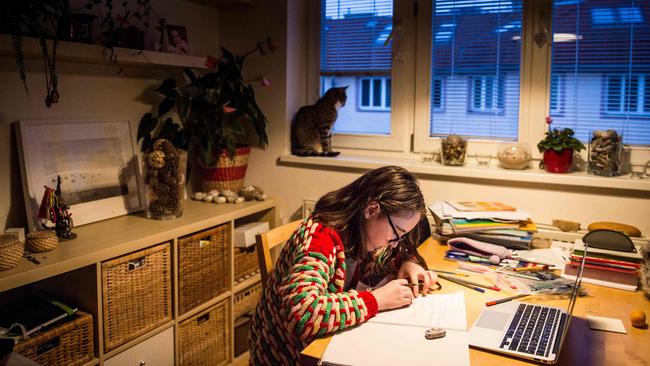
But these ditties are extremely handy in unprecedented times. I have four at home underfoot, ranging from a uni student, one in Year 12 attempting final year studies, one diving into the huge adventure that’s Year 7 and one in Year 3 trying to learn his tables. Let’s just say I begin this whole exercise every morning feeling like Snow White, crisp and clean and contained, trilling away with imaginary bluebirds flying around my head, but end up every afternoon feeling like a combination of Tom (as in Jerry), Oscar (from The Odd Couple) and Cinderella (pre-ball). God I admire teachers, always have, but now … they are my superheroes. This is hard.
So, times tables. The current mode of thinking is that kids need to understand the concepts behind the sums, rather than just reeling off the answers by rote; and through the example of my three older kids I know that schools no longer teach them the old way. I know mine – they were drilled into us every morning, stopwatch hovering, to get us into the correct state of mental alertness for the day. But do our eight-year-old children know theirs? I have primary school memories of the times table grid fresh on the blackboard first thing, to limber us up. Numbers across the top and down the left hand side aaaaaand … go! It was mental arithmetic, it was a race, and it embedded the sums that would be used in some form for the rest of my life.
Through four kids in various schools across two western countries I’ve wondered again and again who’s actually teaching these dear little sums anymore. Is this situation, gulp, actually up to us, the parents? How does it work in all those Asian countries with their amazing PISA (Program for International Student Assessment) scores? Discipline, structure and sheer grit, I suspect. In 2018, Australian 15-year-olds lagged 3.5 years behind their Chinese counterparts in maths, and we’re now in long-term decline.
So how to raise mathematical standards in Australian kids? Parents, dive in, because I suspect it’s the only way for the time being, and of course some of us have so much free time on our hands now to do this. I asked the school of my Year 3 son what age kids are meant to know their times tables by. End of Year 4, I’m cheerily told, and it’s not necessarily up to teachers alone. The more tigerish parents around me talk of charts on bedroom walls and times tables CDs playing in cars. I panic. I was that mother once. Long ago. God help Child Number Four.
But Aussie maths guru Eddie Woo says it’s essential that all students lock down times tables, because they’re a key form of mathematical fluency. “They’re the bedrock for students to become confident in dealing with fractions: the former is about multiplication and the latter is about division, making them natural partners. Children who struggle with times tables will often find fractions, decimals and percentages very difficult to comprehend … you can see how a child’s difficulties with mathematics may have been sown many years in the past.”
Righto. A few years back the British schools minister declared all pupils should have instant recall of times tables by age nine. And our Aussie kids? I don’t think so. “Six times 6 is 36, now go outside to pick up sticks.” Literally, so Oscar from The Odd Couple can transform into Snow White again.




Eight and eight went to the store, to buy Nintendo 64. 56 = 7 x 8 because it’s 5, 6, 7 and 8. Stop! Stop right there! Because we’re no longer meant to learn these natty little short cuts to times tables, we’re not meant to teach our children this way. The current mode of thinking is that kids need to understand the concepts behind the sums, rather than just reeling off the answers by rhyme or rote.